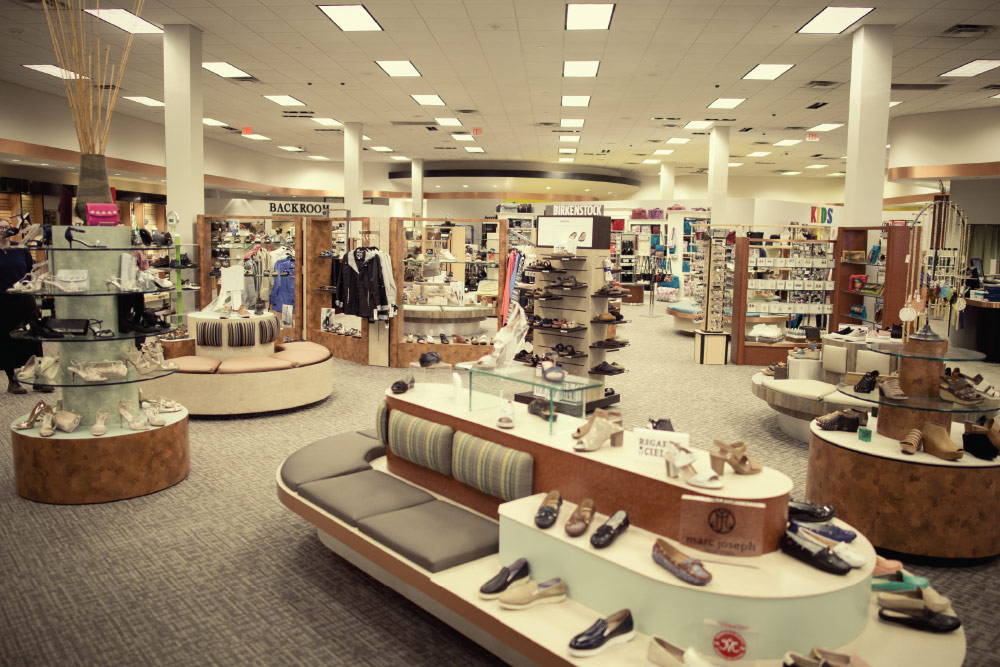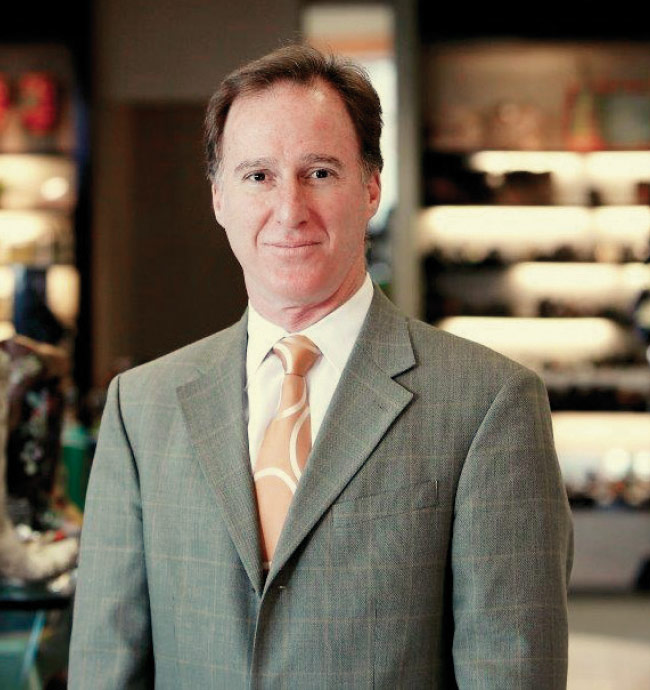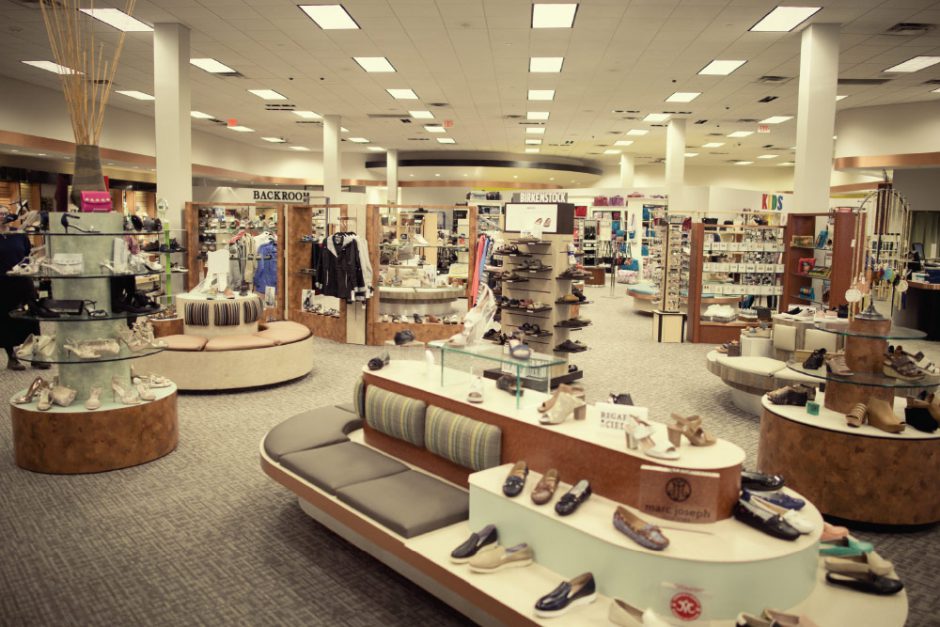 Gary Weiner, longtime president of the two-store Saxon Shoes chain in Richmond, VA, knew his flagship could use a jolt. The 26,000-square-foot family shoe mecca, located in the area’s A-list mall, the Short Pump Town Center, was feeling the effects of the Retail Apocalypse just like everyone else. Saxon’s sales weren’t tanking, but they had been flat the past year—and for the 65-year-old business, that was as bad as being off.
Gary Weiner, longtime president of the two-store Saxon Shoes chain in Richmond, VA, knew his flagship could use a jolt. The 26,000-square-foot family shoe mecca, located in the area’s A-list mall, the Short Pump Town Center, was feeling the effects of the Retail Apocalypse just like everyone else. Saxon’s sales weren’t tanking, but they had been flat the past year—and for the 65-year-old business, that was as bad as being off.
“There was no question that our business needed a makeover,” Weiner says. “It’s been a tougher environment. There’ve been some weather- and business-related things going on—anything that could affect retail, like increased pressure from vendors who are trying to go more direct to consumer (DTC). A makeover couldn’t have come at a better time.”
But a full gut job would be pricey. And who knew if such a big investment would pay off. Thoughts of a full remodel were on the back burner when mall management approached Weiner last year with an unexpected offer to acquire 4,600 square feet of Saxon’s space for a big new tenant. Turns out, it was an offer Weiner couldn’t refuse—even though he did just that at first.
“Once the mall’s offer got too good, we had to take advantage of it,” Weiner says. “The thought of being able to reinvigorate and remodel our store to make it all look brand new—and the mall basically making that happen—was too good to pass up.” The mall covered the remodeling costs and more. Plus, Saxon worked out a rent reduction. “I played as coy as I could because I was incredibly excited,” Weiner says. He credits his grandfather for that bit of negotiating wisdom. “He always said play dumb. So I said, ‘Nah, I’m really not interested in giving up the space.…’ But once the deal got three times better, we signed on the dotted line.”
Weiner is a believer in the power of reinvention, particularly at a time when epic disruption is tearing through all retail tiers. “To continue moving forward in this crazy world, you have to make yourself new again from time to time,” he says. “Customers love it. Employees love it. The community kind of rallies around the new and improved.
“The businesses that are known for being frontrunners, like Nordstrom and Apple, are doing renovations on their stores,” he continues. “In this retail environment, you need to be the store that stands out for new, unique, warm, comfortable, easy. You cannot be your parents’ Oldsmobile and expect any new traffic to come to you.”
But Weiner doesn’t do things half-baked. That’s not the Saxon way. “We went the full Monty,” says Weiner, who took the reins of the family-owned business from his parents in the early ’90s. “We ripped up all of the carpet and tile, we put in new walls, we took out walls, we moved departments around…. We did it all so that when customers walk in, it’s wide open, warm, comfortable and easy to shop.”
By replacing tile with carpet, they gained about 1,500 square feet of floor space for display. Even better, they were able to remodel in stages, which enabled them to stay open for business throughout the process during February.
Digging the New Digs

The new and improved Saxon Shoes features a completely new layout, all on one floor. No more downstairs kids’ department and backroom offices. (No more running up and down the stairs 15 times a day for Weiner.) In addition, the men’s department has been moved to the front of the store, which Weiner says has been a “home run” so far. The women’s department, adjacent at the front, has been spread out further and organized better by idea and lifestyle, whether it’s high fashion, dress or unisex like Birkenstock, which has been given a lot more floor space. Kids’ is in the back. “We even changed our registers desk, which was a sea foam green, to jet black,” Weiner says. “Our regulars have been blown away by the whole new look.”
Weiner believes the one-floor layout provides a much better overall shopping experience. “From a customer perspective, Mom can see everything at one time when she comes in with her kids,” he says. Then there are the internal efficiencies the new layout offers. “It allows us to see the whole floor, and we’ll probably have a 15- to 18-percent reduction in payroll because we don’t need to schedule as many people in every area,” he says. “Before, we needed six to eight people in kids’, 12 in women’s and three in men’s. Because we cross-train our employees, we can now schedule 15 to 17 to work the departments, and we don’t need as many cashiers because there is no downstairs register anymore.” Toss in the rent and tax reductions, and one can see why this remodel is much more than a simple facelift: It’s a good business decision. “When we signed the deal for this space in 2006, it was a percentage deal, so we took all the space we could get,” Weiner says. “In hindsight, managing on two levels is not the easiest thing to do—or the most profitable. That headache is over.”
In addition to reshuffling departments, the store’s decor and vibe have been elevated—a point being promoted in the new tagline “Shoe shopping the way it should be.” What does that mean? “It’s having someone say hello when you come into the store, be able to explain features and benefits, and fit you properly,” Weiner says. “It means really making it worth your while to spend the time to drive someplace and talk to a human being.” He expects such genuine service to win over customers, many of whom are frustrated by automated services. “We measure every kid’s feet, and we offer to measure every man and woman,” he adds. “Every item sold in the kids’ department is double-checked by a manager to make sure it’s right. It’s that feeling of warmth and care again. It’s about customer experience, customer experience…. We want them to tell their friends where they went to get what they got and why they liked shopping here so much.”
Saxon’s effort to humanize the shopping experience coincides with plans to layer in new technologies and services to improve shopping efficiencies and stay current. The iPod checkout, in-store fashion consultants and curbside pickup are all possibilities. “We’re looking at a half a dozen enhancements that we think will make the whole experience better,” Weiner says. “Better” is the operative word. “Everybody should be thinking about ways to have a better business these days—better run and better looking,” he says. “But the main aspect is customers being greeted by someone who is nice, takes care of them, makes them feel good, makes them enjoy giving us their money because, if not, they can spend it someplace else.”
What customers can spend their money on at Saxon Shoes has changed noticeably since the remodeling as well. “We’ve worked hard to bring in a half dozen new vendors that you pretty much only see exhibiting at a Micam show,” Weiner says, quickly adding, “I’m not going to tell you the names. Number one, they don’t mean a whole lot just yet. Second, I’m not going to tell the entire industry to go look at these brands.” What he will say is that these new additions involve fresh looks, higher margins and some exclusivity for a time. They also present an opportunity to attract a younger clientele. “You have to woo the younger generation with current product and brands that bring new concepts to the table—like Toms did when it first hit the scene,” Weiner says, adding that involvement with the local community is also key. “Everybody wants to see that, but young people really like that aspect. If we’re able to stay on top of current trends and we’re in good stead with our community, then I think that younger customer will shop with us.”
Change is Good
A full remodel, new brands added to the mix and even shiny new cash registers—they all reflect the need to adapt and change. Weiner sees living proof of the seismic shifts in consumer habits simply by watching his children, Evan and Amanda. (Both have joined the family business, in technology and social media marketing respectively.) “My kids don’t even know what a bank teller or a bank’s drive-through window is,” he says. “They’re doing all that stuff on their phones, 24-7. If we want to stay in business, we must keep up with the changes and stay engaged with consumers.” For instance, while Weiner says Saxon Shoes can’t get the Dave Matthews Band to play a concert in Richmond, it can sponsor a local music event that draws a younger customer. “We can also work with smaller charities that are focused on targeted causes,” he adds. “These are ways to stay involved with the younger generation. It’s not done by burying your head in the sand.”
One change Weiner does not foresee is leaving his Short Town Pump Center location, despite the fact that it’s in (gasp) a mall. “If you’re in a B or C mall, then you’re probably in a lot of trouble, but fortunately we’re in one of the top malls in the country, and we have a premium location next to the Cheesecake Factory and Urban Outfitters,” he says.
For the time being, Saxon Shoes is comfortable in its brick-and-mortar skin. “You have to decide where you are going to make your play,” Weiner says. “Ours is the middle-upper market focused on women and men 35-plus, and we just have to figure out how to work around all these challenges. That’s why we’re calling it ‘shoe shopping the way it shoould be.’ Someone greeting you, explaining features and benefits, measuring you, being able to walk out the door with a purchase instantaneously, being able to return it without having to mail it…there are many advantages to what we offer.”
The question Weiner is asking himself now is whether to expand his store count. There are voids being created by today’s retail bloodbath. “There are probably fewer people going into stores, but there are still a lot of people doing so,” he says. Where does Weiner envision Saxon Shoes five years down the road? “I’d say it’s 15 stores or I’m sitting on a beach,” he says. His point? Standing still isn’t an option. “You have to be thinking about how you’re going to grow or how to get out,” he says. “It’s either-or, and I think about both all the time.”
That’s the life of a retailer. It’s not easy. It never was. “These are challenging times, but they’ve always been challenging,” Weiner says. “The ’70s, ’80s, ’90, ’00s were all challenging. It’s just different and a little swifter today. They’re challenges all the same, and my job is to overcome them.”




